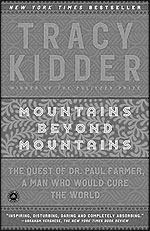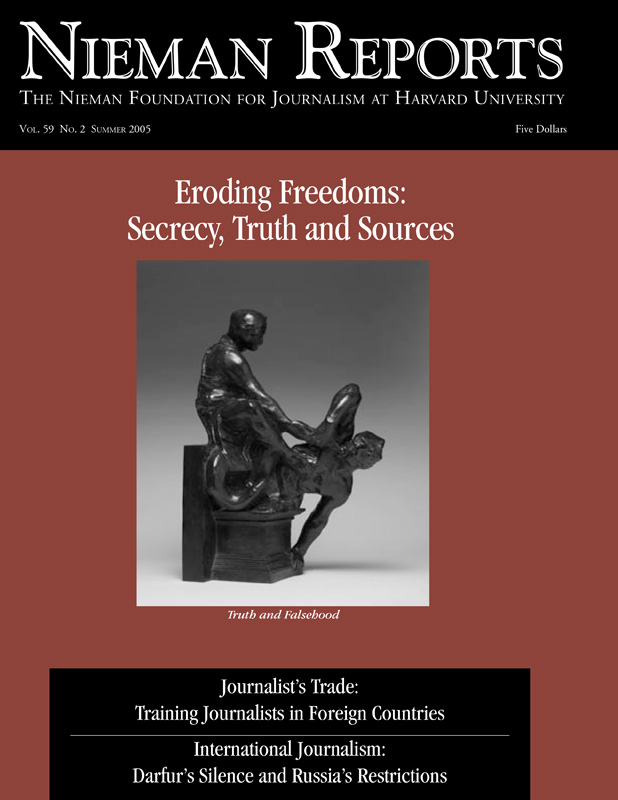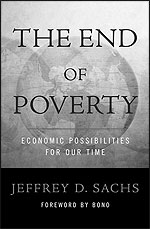
Mountains Beyond Mountains: The Quest of Dr. Paul Farmer, a Man Who Would Cure the World
Tracy Kidder
Random House. 322 Pages. $14.95 pb.What will journalists do about the world’s poor before poverty breaks the world apart? This question, bordering on accusation, challenges the American media’s role in creating a global civil society. I certainly hear such querulous semirebukes from my international Nieman colleagues, as well as from other journalists.
The Weatherhead Center for International Affairs at Harvard recently asked me to give a journalist’s reply to the Madrid Agenda. This document emerged in March 2005 as a multinational democratic response to the global threat of terrorism. It defines poverty as an “underlying risk factor,” giving “rise to grievances that are often exploited by terrorists.” In my reply at the Weatherhead Center, I explained that there is no “the media” capable of working in any kind of unified, Pan-journalistic program that might seek to spotlight solutions. Yes, many journalists do care that the effects of poverty are causing the deaths of many millions of people each year and pushing others to resort to violence. But in our role—as observers and chroniclers—our caregiving has to come through in how we write, photograph and record about what we see and hear and learn.
What I didn’t say that day, but often ask myself, is whether the press pays attention to the issues of poverty on an order of magnitude that will make any difference in the back-of-the-hand response that the poorest of the poor now receive from wealthier nations. The answer I arrive at makes me so uncomfortable that I’m glad to be the one raising the issue instead of hearing this asked by critics.
Now I am asking journalists: Do our broadcast and print news media provide adequate coverage of practices and policies that might move us toward alleviating third-world poverty in our time? I thought not. So I’ve got two books to suggest as essential reading for all news reporters and editors. One is about a physician who works with the poor, the other about a money doctor with a prescription for poverty itself. Both see themselves as practitioners of practicality and not as feel-good sympathizers for those who are most impoverished.
Healing Poverty and the Poor
On the day I encountered Dr. Paul Farmer he was debating a Harvard Business School professor and, in doing so, a giant crack in the earth opened up between their opposing views. Then I watched as Farmer worked to close this chasm by engaging in a human rights argument about drug prescriptions for the poor. This feat of verbal earthmoving would not surprise people who know about Farmer from reading Tracy Kidder’s book, “Mountains Beyond Mountains,” a narrative important for both its style and its content as it documents Farmer’s successful approach to caring for and curing the world’s poor.
Economist Jeffrey Sachs pulls off a similar feat of earth-healing in his book, “The End of Poverty.” As perhaps the world’s preeminent money doctor— curing the economic crises of poor nations such as Bolivia and India—he presents a plan for improving the world’s social health by cantilevering a bridge of economic revival in the direction of the world’s desperately poor. Let’s be clear. Reaching out to the poor and the sick is no mere act of feelgood charity to benefit someone else or to assuage personal and corporate guilt. It is, as Sachs explains, in the self-interest of richer nations to do this so the global community won’t explode from the fissures and fractures that increasingly divide the world’s wealthy and destitute peoples. This strategy is not unlike when Martin Luther King, Jr. reached out to whites of the Southern business class during the civil rights movement. He argued they were also enslaved in their own way, as they were held back from progress by the consequences of racial hatred. Crossing the fault line of segregation produced economic miracles for all ethnicities.
Poverty and race are the never-ending stories. But journalists, at the very least, ought to be trying to open new chapters, just as Sachs and Farmer are doing. All around us there are canyons and crevices, dividing the haves from the have-nots. Journalists are bridgebuilders, too, who can contribute to better connecting our divisive world. In doing this, both of these books are needed guides as they grab and shake us with the details of experience, then pull us to respond with a more expansive look at how these experiences fit into the many difficult global issues of our time.
The pharmaceutical debate I witnessed between Farmer and the business school professor summed up the problem and solution, or at least it gave hints of an attitude that could lead us closer to solving these issues. Without patents and profits and private ownership, the professor intoned, new drugs can’t be developed to save patients (at least those who can afford to buy them, I say to myself). Without finding ways to provide treatment, the physician replied, people die.
What came next was the chasm closing. Farmer, the renowned Harvard epidemiologist and Haiti-based medical anthropologist, turned out to be wellversed on the contract law of patents. He was not in favor of scrapping them in some either/or social insurrection but suggested creating a differentiated system that would allow for sharing the benefits of medical science and miracle drugs. (As he spoke, I thought of the broadcast law analogy in which licensees provided public service airtime.)
And why would big drug companies, and our society, want to do such a thing? As Farmer explains, the dread diseases of the developing parts of the world—in our era of massive global interaction—will infect those who live in industrialized nations as surely as HIV/AIDS found its way from abroad. The bridge Farmer offers has self-interest as its foundation.
Germs and infections, even plagues, are the monsters that fill the chasms separating the wealthy and the poor states. Complete homeland defense means keeping an attentive eye on natural killers as well as on human terrorists. Today we hear reasons why we might fear that an avian flu outbreak will arrive at our shores, or the Marburg and Ebola viruses will spread as have drug-resistant strains of tuberculosis. The recent accidental dispersal of an old killer influenza sent mistakenly to labs in a bureaucratic foul-up raised this awareness anew.
Kidder frames Farmer with a wider landscape than simply an engaging portrait of this passionate and compassionate physician who would squash all these bugs. The doctor knows what it is like to grow up poor and emerges as lively and brilliant. He adopts liberation theology’s preferential option for the poor. Farmer is, in short, almost too good to be true—our generation’s Albert Schweitzer. But in learning about him, we also discover the organizational success story of Farmer’s Partners In Health (PIH), which in these forsaken places manages to overturn problematic world health orthodoxy, solve drugresistant disease problems, address epidemics one patient at a time, and meet the various economic problems caused by poor health. And PIH does all of this at a cost that is a fraction of conventional U.S. methods, which get a relatively low return on their substantial medical investment.
In a question-and-answer session at Lippmann House, I suggest to Farmer that he dances and plays between the feet of giants as he works to win over big institutions, world health agencies, and governments to his way of thinking and acting. With a twinkle, the tall and angular physician admits he might like to kick the titans in their shins, but that’s a way to get trampled. So he moves would-be opponents by kindness and steadiness, closing these chasms along the way.
Books That Matter
Only the naive believe that there are no obstacles or opposition to solving world health and poverty problems. But with books like these available, only the unread will lack the mental images of possible solutions. Journalists like to study the Pulitzer-winning Tracy Kidder for his narrative reporting and writing and rightly so. Now with “Mountains Beyond Mountains,” (named for a Haitian proverb that suggests never-ending stories), not only is Kidder’s storytelling worth our study, but also its content is vital to our business.
Solutions-beyond-solutions describes “The End of Poverty.” Turn quickly through the forward by Bono, the rock star who impels the global antipoverty effort with his pop charisma but adds little more than his name to this important book. Sachs, who directs The Earth Institute at Columbia and advises the United Nations on its Millennium Development goals, harnesses the university’s academic and technological expertise with business and government connections to prod forward transnational transformation. Who better to prescribe remedies for what ails poorer nations? What Sachs has to say is not the stale lessons of Economics 101; it’s the real stuff of life and is only boring to those who have not yet opened their eyes to what is happening around us. In his book, Sachs is reportorial about what works and doesn’t work in realworld experience. He’s been there, and he can explain it well (if not with Kidder’s writerly narrative) with his clear thinking and you-are-there results from his travels and work.
From the start, Sachs braces a reader for the exhilarating ride ahead: “Currently, more than eight million people around the world die each year because they are too poor to stay alive. Our generation can choose to end that extreme poverty by the year 2025.” And in a similar way, Farmer speaks out of his experience about how untreated disease can cross from poor states into rich. Sachs writes, too, of the dark side of globalization, as effects of rising populations and declining food production, lack of technology and barriers to promoting public health, geographic difficulties and political upheaval, economic shocks and natural disasters (like last year’s tsunami) reverberate in developed nations.
Sachs patiently explains that rich countries don’t have to transfer their wealth to these poorer ones. What they do need to do, however, is to invest enough to allow these poorer nations an upward foothold on the ladder, and then the cascade of technological change will do the rest. He suggests that a good place for the wealthy Western countries to start would be to deliver the funds they’ve already promised to programs that actually provide services to poor people. Instead of funding, as they now do, a vast, inefficient bureaucracy of agencies and advisors (each with a cut of the overhead), Sachs offers a reality-based vision of how to restructure aid programs so money does what it is supposed to do.
In the absence of this kind of restructuring and real solutions, terrorism becomes the return on our misguided investments. The Bush administration launched a war on terror, Sachs points out, while neglecting many of the deeper causes of global instability: “The $450 billion that the United States will spend this year on the military will never buy peace if it continues to spend around one-thirtieth of that, just $15 billion, to address the plight of the world’s poorest of the poor, whose societies are destabilized by extreme poverty and thereby become havens of unrest, violence and even global terrorism.”
It is not fully apparent how good Sachs is at playing among the feet of giants and, as with Farmer, I get the impression he’d rather kick’em in the shins when they won’t listen up. But one comes away from reading his book with the sense that nobody is going to squash him: He’s too informed, too experienced, and too right about what he’s saying.
What choices will news organizations make in the years ahead about coverage of the world’s poor and their problems? Will the effects of poverty on African communities, for example, remain a rarely told story? And how will we assess our efforts in this regard a decade from how? Did we do enough to inform ourselves about these critical issues?
If we didn’t start by using these two books as guides, then already I know what my answer is. We didn’t.
Chris Waddle, a 2005 Nieman Fellow, is vice president/news of Consolidated Publishing Co., publishers of The Anniston (Ala.) Star. He also is president of the Ayers Family Institute for Community Journalism that partners with the Knight Foundation and University of Alabama to offer a master’s degree in community journalism, to be taught inside the Anniston newspaper beginning in 2006.



